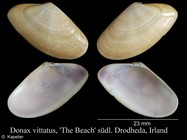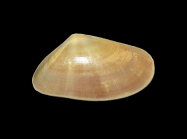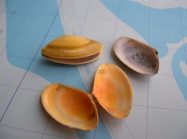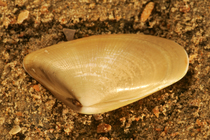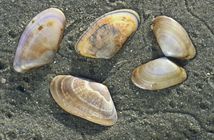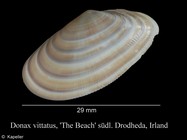Scheldt species taxon details
Donax vittatus (da Costa, 1778)
139604 (urn:lsid:marinespecies.org:taxname:139604)
accepted
Species
marine
(of ) Da Costa, E. M. (1778). <i>Historia naturalis testaceorum Britanniæ, or, the British conchology</i>; containing the descriptions and other particulars of natural history of the shells of Great Britain and Ireland: illustrated with figures. In English and French. - Historia naturalis testaceorum Britanniæ, ou, la conchologie Britannique; contenant les descriptions & autres particularités d'histoire naturelle des coquilles de la Grande Bretagne & de l'Irlande: avec figures en taille douce. En anglois & françois. i-xii, 1-254, i-vii, [1], Pl. I-XVII. London. (Millan, White, Emsley & Robson). , available online at https://www.biodiversitylibrary.org/page/13116783
page(s): 207-208; pl. 14 fig. 3 [details]
page(s): 207-208; pl. 14 fig. 3 [details]
MolluscaBase eds. (2021). MolluscaBase. Donax vittatus (da Costa, 1778). Accessed through: VLIZ Consortium Scheldt Species Register at: https://www.scheldemonitor.org/speciesregister/aphia.php?p=taxdetails&id=139604 on 2025-09-11
VLIZ Consortium. Scheldt Species Register. Donax vittatus (da Costa, 1778). Accessed at: https://scheldemonitor.be/speciesregister/aphia.php?p=taxdetails&id=139604 on 2025-09-11
Date
action
by
original description
(of ) Da Costa, E. M. (1778). <i>Historia naturalis testaceorum Britanniæ, or, the British conchology</i>; containing the descriptions and other particulars of natural history of the shells of Great Britain and Ireland: illustrated with figures. In English and French. - Historia naturalis testaceorum Britanniæ, ou, la conchologie Britannique; contenant les descriptions & autres particularités d'histoire naturelle des coquilles de la Grande Bretagne & de l'Irlande: avec figures en taille douce. En anglois & françois. i-xii, 1-254, i-vii, [1], Pl. I-XVII. London. (Millan, White, Emsley & Robson). , available online at https://www.biodiversitylibrary.org/page/13116783
page(s): 207-208; pl. 14 fig. 3 [details]
context source (Schelde) Maris, T., O. Beauchard, S. Van Damme, E. Van den Bergh, S. Wijnhoven & P. Meire. (2013). Referentiematrices en Ecotoopoppervlaktes Annex bij de Evaluatiemethodiek Schelde-estuarium Studie naar “Ecotoopoppervlaktes en intactness index”. [Reference matrices and Ecotope areas Annex to the Evaluation methodology Scheldt estuary Study on “Ecotope areas and intactness index”. <em>Monitor Taskforce Publication Series, 2013-01. NIOZ: Yerseke.</em> 35 pp. (look up in IMIS) [details]
context source (BeRMS 2020) Marine Biology Section, Ugent. Belgium. INRAM. Benthic fauna monitoring- SSD - Belgian Science Policy., available online at http://www.vliz.be/projects/inram/imers.php. [details]
basis of record Gofas, S.; Le Renard, J.; Bouchet, P. (2001). Mollusca. in: Costello, M.J. et al. (eds), European Register of Marine Species: a check-list of the marine species in Europe and a bibliography of guides to their identification. <em>Patrimoines Naturels.</em> 50: 180-213., available online at http://www.vliz.be/imisdocs/publications/ocrd/254404.pdf [details]
additional source Webb C.M. (1986). Post-larval development of the tellinacean bivalves <i>Abra alba</i>, <i>Tellina fabula</i> and <i>Donax vittatus</i> (Mollusca, Bivalvia), with reference to the late larva. <em>Journal of the Marine Biological Association of the United Kingdom.</em> 66: 749-762. [details] Available for editors
identification resource Cosel, R. von; Gofas, S. (2019). <i>Marine bivalves of tropical West Africa: from Rio de Oro to southern Angola</i>. Publications Scientifiques du Muséum, Paris, IRD Éditions, Marseille (Faune et Flore tropicales, volume 48): 1-1104.
page(s): 650-651 [details]
page(s): 207-208; pl. 14 fig. 3 [details]
context source (Schelde) Maris, T., O. Beauchard, S. Van Damme, E. Van den Bergh, S. Wijnhoven & P. Meire. (2013). Referentiematrices en Ecotoopoppervlaktes Annex bij de Evaluatiemethodiek Schelde-estuarium Studie naar “Ecotoopoppervlaktes en intactness index”. [Reference matrices and Ecotope areas Annex to the Evaluation methodology Scheldt estuary Study on “Ecotope areas and intactness index”. <em>Monitor Taskforce Publication Series, 2013-01. NIOZ: Yerseke.</em> 35 pp. (look up in IMIS) [details]
context source (BeRMS 2020) Marine Biology Section, Ugent. Belgium. INRAM. Benthic fauna monitoring- SSD - Belgian Science Policy., available online at http://www.vliz.be/projects/inram/imers.php. [details]
basis of record Gofas, S.; Le Renard, J.; Bouchet, P. (2001). Mollusca. in: Costello, M.J. et al. (eds), European Register of Marine Species: a check-list of the marine species in Europe and a bibliography of guides to their identification. <em>Patrimoines Naturels.</em> 50: 180-213., available online at http://www.vliz.be/imisdocs/publications/ocrd/254404.pdf [details]
additional source Webb C.M. (1986). Post-larval development of the tellinacean bivalves <i>Abra alba</i>, <i>Tellina fabula</i> and <i>Donax vittatus</i> (Mollusca, Bivalvia), with reference to the late larva. <em>Journal of the Marine Biological Association of the United Kingdom.</em> 66: 749-762. [details] Available for editors
identification resource Cosel, R. von; Gofas, S. (2019). <i>Marine bivalves of tropical West Africa: from Rio de Oro to southern Angola</i>. Publications Scientifiques du Muséum, Paris, IRD Éditions, Marseille (Faune et Flore tropicales, volume 48): 1-1104.
page(s): 650-651 [details]
 Present
Present  Inaccurate
Inaccurate  Introduced: alien
Introduced: alien  Containing type locality
Containing type locality
| Language | Name | |
|---|---|---|
| Dutch | zaagjegewoon zaagje | [details] |
| English | banded wedge-shellbanded wedge clambanded donax | [details] |
Encyclopedia of Marine Life of Britain and Ireland
Marine Life Information Network - UK
To Barcode of Life (84 barcodes)
To Biodiversity Heritage Library (147 publications)
To Dyntaxa
To European Nucleotide Archive, ENA (Donax vittatus)
To GenBank (263 nucleotides; 200 proteins)
To Malacopics (Donax vittatus (da Costa, 1778) Netherlands, Friesland, Terschelling, beachmarker 11, beached, collected May 1995, ex coll. J. Trausel)
To Malacopics (Donax vittatus (da Costa, 1778))
To Marine Bivalves of the British Isles webpage at National Museum of Wales
To PESI
To ITIS
Marine Life Information Network - UK
To Barcode of Life (84 barcodes)
To Biodiversity Heritage Library (147 publications)
To Dyntaxa
To European Nucleotide Archive, ENA (Donax vittatus)
To GenBank (263 nucleotides; 200 proteins)
To Malacopics (Donax vittatus (da Costa, 1778) Netherlands, Friesland, Terschelling, beachmarker 11, beached, collected May 1995, ex coll. J. Trausel)
To Malacopics (Donax vittatus (da Costa, 1778))
To Marine Bivalves of the British Isles webpage at National Museum of Wales
To PESI
To ITIS
